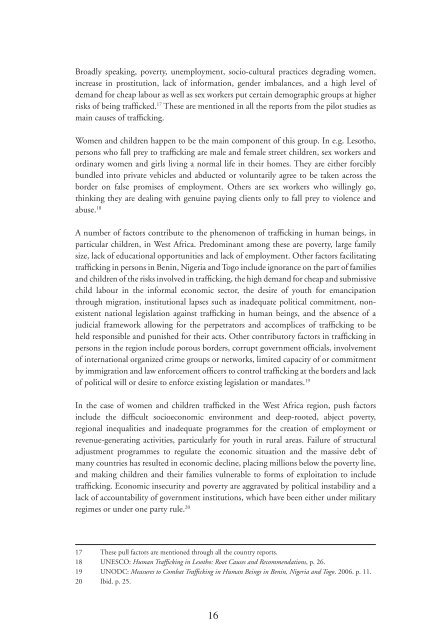Trafficking in human beings: human rights and ... - unesdoc - Unesco
Trafficking in human beings: human rights and ... - unesdoc - Unesco
Trafficking in human beings: human rights and ... - unesdoc - Unesco
You also want an ePaper? Increase the reach of your titles
YUMPU automatically turns print PDFs into web optimized ePapers that Google loves.
Broadly speak<strong>in</strong>g, poverty, unemployment, socio-cultural practices degrad<strong>in</strong>g women,<br />
<strong>in</strong>crease <strong>in</strong> prostitution, lack of <strong>in</strong>formation, gender imbalances, <strong>and</strong> a high level of<br />
dem<strong>and</strong> for cheap labour as well as sex workers put certa<strong>in</strong> demographic groups at higher<br />
risks of be<strong>in</strong>g traffi cked. 17 These are mentioned <strong>in</strong> all the reports from the pilot studies as<br />
ma<strong>in</strong> causes of traffi ck<strong>in</strong>g.<br />
Women <strong>and</strong> children happen to be the ma<strong>in</strong> component of this group. In e.g. Lesotho,<br />
persons who fall prey to traffi ck<strong>in</strong>g are male <strong>and</strong> female street children, sex workers <strong>and</strong><br />
ord<strong>in</strong>ary women <strong>and</strong> girls liv<strong>in</strong>g a normal life <strong>in</strong> their homes. They are either forcibly<br />
bundled <strong>in</strong>to private vehicles <strong>and</strong> abducted or voluntarily agree to be taken across the<br />
border on false promises of employment. Others are sex workers who will<strong>in</strong>gly go,<br />
th<strong>in</strong>k<strong>in</strong>g they are deal<strong>in</strong>g with genu<strong>in</strong>e pay<strong>in</strong>g clients only to fall prey to violence <strong>and</strong><br />
abuse. 18<br />
A number of factors contribute to the phenomenon of traffi ck<strong>in</strong>g <strong>in</strong> <strong>human</strong> be<strong>in</strong>gs, <strong>in</strong><br />
particular children, <strong>in</strong> West Africa. Predom<strong>in</strong>ant among these are poverty, large family<br />
size, lack of educational opportunities <strong>and</strong> lack of employment. Other factors facilitat<strong>in</strong>g<br />
traffi ck<strong>in</strong>g <strong>in</strong> persons <strong>in</strong> Ben<strong>in</strong>, Nigeria <strong>and</strong> Togo <strong>in</strong>clude ignorance on the part of families<br />
<strong>and</strong> children of the risks <strong>in</strong>volved <strong>in</strong> traffi ck<strong>in</strong>g, the high dem<strong>and</strong> for cheap <strong>and</strong> submissive<br />
child labour <strong>in</strong> the <strong>in</strong>formal economic sector, the desire of youth for emancipation<br />
through migration, <strong>in</strong>stitutional lapses such as <strong>in</strong>adequate political commitment, nonexistent<br />
national legislation aga<strong>in</strong>st traffi ck<strong>in</strong>g <strong>in</strong> <strong>human</strong> be<strong>in</strong>gs, <strong>and</strong> the absence of a<br />
judicial framework allow<strong>in</strong>g for the perpetrators <strong>and</strong> accomplices of traffi ck<strong>in</strong>g to be<br />
held responsible <strong>and</strong> punished for their acts. Other contributory factors <strong>in</strong> traffi ck<strong>in</strong>g <strong>in</strong><br />
persons <strong>in</strong> the region <strong>in</strong>clude porous borders, corrupt government offi cials, <strong>in</strong>volvement<br />
of <strong>in</strong>ternational organized crime groups or networks, limited capacity of or commitment<br />
by immigration <strong>and</strong> law enforcement offi cers to control traffi ck<strong>in</strong>g at the borders <strong>and</strong> lack<br />
of political will or desire to enforce exist<strong>in</strong>g legislation or m<strong>and</strong>ates. 19<br />
In the case of women <strong>and</strong> children traffi cked <strong>in</strong> the West Africa region, push factors<br />
<strong>in</strong>clude the diffi cult socioeconomic environment <strong>and</strong> deep-rooted, abject poverty,<br />
regional <strong>in</strong>equalities <strong>and</strong> <strong>in</strong>adequate programmes for the creation of employment or<br />
revenue-generat<strong>in</strong>g activities, particularly for youth <strong>in</strong> rural areas. Failure of structural<br />
adjustment programmes to regulate the economic situation <strong>and</strong> the massive debt of<br />
many countries has resulted <strong>in</strong> economic decl<strong>in</strong>e, plac<strong>in</strong>g millions below the poverty l<strong>in</strong>e,<br />
<strong>and</strong> mak<strong>in</strong>g children <strong>and</strong> their families vulnerable to forms of exploitation to <strong>in</strong>clude<br />
traffi ck<strong>in</strong>g. Economic <strong>in</strong>security <strong>and</strong> poverty are aggravated by political <strong>in</strong>stability <strong>and</strong> a<br />
lack of accountability of government <strong>in</strong>stitutions, which have been either under military<br />
regimes or under one party rule. 20<br />
17 These pull factors are mentioned through all the country reports.<br />
18 UNESCO: Human Traffi ck<strong>in</strong>g <strong>in</strong> Lesotho: Root Causes <strong>and</strong> Recommendations, p. 26.<br />
19 UNODC: Measures to Combat Traffi ck<strong>in</strong>g <strong>in</strong> Human Be<strong>in</strong>gs <strong>in</strong> Ben<strong>in</strong>, Nigeria <strong>and</strong> Togo. 2006. p. 11.<br />
20 Ibid. p. 25.<br />
16

















